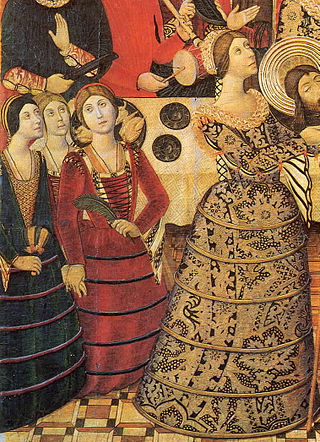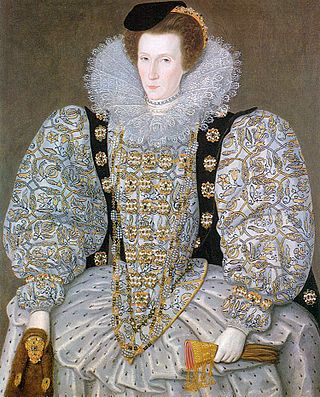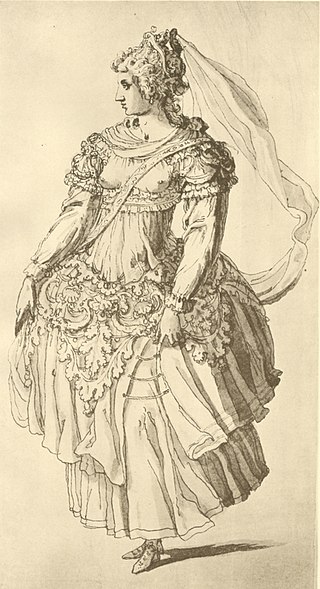Related Research Articles

A farthingale is one of several structures used under Western European women's clothing - especially in the 16th and 17th centuries - to support the skirts in the desired shape and to enlarge the lower half of the body. The fashion originated in Spain in the fifteenth century. Farthingales served important social and cultural functions for women in Renaissance Europe as they expressed, primarily when worn by court women, high social position and wealth.

George Home, 1st Earl of Dunbar, KG, PC was, in the last decade of his life, the most prominent and most influential Scotsman in England. His work lay in the King's Household and in the control of the State Affairs of Scotland and he was the King's chief Scottish advisor. With the full backing and trust of King James he travelled regularly from London to Edinburgh via Berwick-upon-Tweed.

The Vision of the Twelve Goddesses was an early Jacobean-era masque, written by Samuel Daniel and performed in the Great Hall of Hampton Court Palace on the evening of Sunday, 8 January 1604. One of the earliest of the Stuart Court masques, staged when the new dynasty had been in power less than a year and was closely engaged in peace negotiations with Spain, The Vision of the Twelve Goddesses stood as a precedent and a pattern for the many masques that followed during the next four decades.

A zibellino, flea-fur or fur tippet is a women's fashion accessory popular in the later 15th and 16th centuries. A zibellino, from the Italian word for "sable", is the pelt of a sable or marten worn draped at the neck or hanging at the waist, or carried in the hand. The plural is zibellini. Some zibellini were fitted with faces and paws of goldsmith's work with jeweled eyes and pearl earrings, while unadorned furs were also fashionable.
Perfumed gloves, also referred to as sweet gloves, are perfumed gloves, often embroidered, introduced to England from Spain and Venice. They were popular as gifts in the 16th and 17th-centuries. Stories describe them as a conveyance of poison for Jeanne d'Albret and Gabrielle d'Estrees.
Costume and gold and silver plate belonging to Elizabeth I were recorded in several inventories, and other documents including rolls of New Year's Day gifts. Arthur Jefferies Collins published the Jewels and Plate of Queen Elizabeth I: The Inventory of 1574 from manuscripts in 1955. The published inventory describes jewels and silver-plate belonging to Elizabeth with detailed references to other source material. Two inventories of Elizabeth's costume and some of her jewellery were published by Janet Arnold in Queen Elizabeth's Wardrobe Unlocke'd.
Lady Audrey Walsingham was an English courtier. She served as Lady of the Bedchamber to queen Elizabeth I of England, and then as Mistress of the Robes to Anne of Denmark from 1603 until 1619.
Mary Gargrave was a courtier to Anne of Denmark.
Dorothy Silking, was a Danish courtier, one of the chamberers in the household of Anne of Denmark.
Mary Radcliffe or Ratcliffe (1550-1617) was a courtier of Queen Elizabeth I of England.
The Harefield Entertainment included hospitality and performances for Elizabeth I of England in August 1602. Several copies of the performance script survive, probably written by John Davies, along with the original manuscript accounts of the Queen's host which seems to have been manipulated by literary forgery in the 19th-century to enhance their interest.

The jewels of Anne of Denmark (1574–1619), wife of James VI and I and queen consort of Scotland and England, are known from accounts and inventories, and their depiction in portraits by artists including Paul van Somer. A few pieces survive. Some modern historians prefer the name "Anna" to "Anne", following the spelling of numerous examples of her signature.

The wardrobe of Mary, Queen of Scots, was described in several contemporary documents, and many records of her costume have been published.

William Cookesbury or Coksbery, or Cookisbury was a London capper, haberdasher, and supplier of feathers.

Oes or owes were metallic O-shaped rings or eyelets sewn on to clothes and furnishing textiles for decorative effect. They were used on various clothing and furnishing fabrics and were smaller than modern sequins. Made of gold, silver, or copper, oes were made either from rings of wire or out of a sheet of metal.

Christopher Shawe or Shaw was an English embroiderer and textile artist who worked on masque costume for Anne of Denmark. He was a member of the Worshipful Company of Broderers.
A silkwoman was a woman in medieval, Tudor, and Stuart England who traded in silks and other fine fabrics. London silkwomen held some trading rights independently from their husbands and were exempted from some of the usual customs and laws of coverture. The trade and craft of the silkwoman was encouraged by a statute of Henry VI of England as a countermeasure to imports of silk thread, and a suitable occupation for "young gentlewomen and other apprentices".
A chamberer was a female attendant of an English queen regnant, queen consort, or princess. There were similar positions in aristocratic households.

Walter Fyshe was a London tailor who worked for Elizabeth I until 1582. He also made some of her farthingales. Fyshe made the queen's ceremonial clothes and coronation robes, altering robes made for the coronation of Mary I of England.
A safeguard was a riding garment or overskirt worn by women in the sixteenth and seventeenth centuries. Some safeguards were intended to protect skirts or kirtles worn beneath. Mary Frith, dramatised as the character Moll Cutpurse in The Roaring Girl, wore a black safeguard over breeches.
References
- ↑ Patricia Wardle, 'Divers necessaries for his Majesty's use and service: Seamstresses to the Stuart Kings', Costume, 31:1 (January 1997), p. 16.
- ↑ J. H. Lefroy, Memorials of the Discovery and Early Settlement of The Bermudas or Somers Islands, vol. 1 (London, 1877), p. 99
- ↑ W. Phillimore, The Visitation of Worcestershire, 1569 (Harleian Society, London, 1888), p. 7.
- ↑ Patricia Wardle, 'Divers necessaries for his Majesty's use and service: Seamstresses to the Stuart Kings', Costume, 31:1 (January 1997), p. 25 fn. 2, Wardle uses the spelling 'Speccart', found in some wardrobe accounts.
- ↑ John Nichols, The progresses and public processions of Queen Elizabeth, vol. 3 (London, 1828), pp. 456-7.
- ↑ Transcription of 1604 Livery roll of the Royal Household, TNA LC1604/6/
- ↑ Janet Arnold, Queen Elizabeth's Wardrobe Unlock'd (Leeds, 1988), pp. 226-7.
- ↑ Janet Arnold, Queen Elizabeth's Wardrobe Unlock'd (Maney, 1988), pp. 315–16.
- ↑ Charles Angell Bradford, Helena, Marchioness of Northampton (London, 1936), pp. 280-281.
- ↑ 'Sir Nicholas Bacon Collection in the University of Chicago Library', MS. 3835, 27 April 1604.
- ↑ Jemma Field, 'The Wardrobe Goods of Anna of Denmark', Costume, 51:1 (March 2017), p. 20 & Supplement p. 44 no. 381.
- ↑ British Library Add. MS 15649: TNA SP 14/211 f.51.
- ↑ HMC Salisbury Hatfield, vol. 19 (London, 1965), p. 290.
- ↑ Martin Wiggins & Catherine Richardson, British Drama, 1533-1642: A Catalogue, vol. 5 (Oxford, 2012), p. 69.
- ↑ Folger Shakespeare Library, catalogue X.d.572
- ↑ Colin Brett, 'The Manors of Norton St Philip and Hinton Charterhouse', Somerset Record Society, 93 (2007), p. 151.
- ↑ Allen Hinds, Calendar State Papers, Venice: 1617-1619, vol. 15 (London, 1909), pp. 80-1: HMC 7th Report: Graham (London, 1879), p. 255: TNA SP14/107 f.121.
- ↑ Fanny Bury Palliser, History of Lace (London, 1865), p. 299.
- ↑ John Nichols, Progresses of James First, vol. 3 (London, 1828), p. 541.
- ↑ M. T. W. Payne, 'An inventory of Queen Anne of Denmark's 'stuffe' at Denmark House, 1619', Journal of the History of Collecting, 13:1 (2001), pp. 40, 44 fn. 75.
- ↑ The National Archive TNA Speckart v Ferrers, C 2/JasI/S15/33.
- ↑ J. H. Lefroy, Memorials of the Discovery and Early Settlement of The Bermudas or Somers Islands, vol. 1 (London, 1877), p. 100.
- ↑ Patricia Wardle, 'Divers necessaries for his Majesty's use and service: Seamstresses to the Stuart Kings', Costume, 31:1 (January 1997), pp. 16–19: 'Warrant to Sir Henry Mildmay, Master of the Jewels', Somerset Heritage Centre, reference; DD\MI/19/40.
- ↑ John Parton, Some Account of the Hospital and Parish of St. Giles in the Fields, Middlesex (London, 1822), pp. 215, 226, 356-7: 'Will of Abraham Speckart or Sneckart, Gentleman of Saint Giles in the Fields, Middlesex', 18 February 1642, TNA PROB 11/188/275.
- ↑ Journals of the House of Commons, vol. 5, p. 356: Notes & Queries, 2nd Series VII (March, 1859), p. 193.